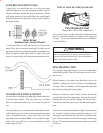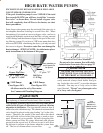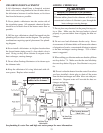
21
These chemical outlines should not be considered as a
“how to” balance your pool/spa water, but just a refer-
ence on how chemical balance effects the heater and gives
suggested test values. You should always consult a pool
professional and follow all chemical manufacturers di-
rections,
unless they conflict with this manual.
CHLORINE
Chlorine
levels should remain within a range from 1
p.p.m. to a maximum of 5 p.p.m. (p.p.m.=parts per mil-
lion). Excessive chlorine saturation of the pool water will
cause corrosive damage to the heat exchanger.
Chlorines Effect on pH
Review the diagram on the previous page. Some tablets,
granular and gas forms of chlorine have an acetic nature
to start with and may lower the pH of the water when
introduced (see diagram on previous page). Be sure that
the pH remains between 7.4 and 7.8 after adding chlo-
rine. If these types of chlorine are introduced into the
system in the wrong place, you can run full strength chlo-
rine through the heat exchanger before it has a chance to
mix with the rest of the pool water. See the next section
on chemical usage and chlorinator placement.
Shock Treatments
A shock treatment is a large dose of chlorine added to the
pool water all at once to reduce the amount of combined
(contaminated) chlorine in the water or to kill algae. Make
sure you do not over shock treat, calculate the exact
amount of chlorine needed. When “shock treating” the
pool make sure that the pH levels remain at the prescribed
levels after the chlorine is introduced. Do not add any
more chlorine to the water until the chlorine levels have
dropped to normal. Prolonged high chlorine levels will
cause damage to the heat exchanger. The combination of
high chlorine and low pH (acetic) will deteriorate the heat
exchanger at an accelerated rate. Do not add shock treat-
ment or chlorine tablets in the skimmer.
Read and follow the chemical manufacturers directions
when adding chemicals unless they conflict with this book-
let. Contact your dealer or the factory service department
for advice.
pH
The pH level in your pool should be maintained within
the range of 7.4 to 7.8. A pH test will tell you how
acetic or how alkaline the pool water is. For example,
acetic like orange juice or alkaline like milk. A 7.6 pH
is considered the middle of the road. Lower than 7.6
means that the water has an acetic tendency. Higher
than 7.6 indicates that the water has alkaline tendency.
pH Below 7.4 Will...
A lower (acetic) pH reading will cause corrosion to the
heat exchanger. Prolonged exposure to low pH and / or
high chlorine will damage the heat exchanger. The
lower the pH the more aggressive the chlorine is and
the quicker the damage takes place. The metal is oxi-
dized and deteriorates.
Piping Leaks & Stains
An early indicator of low pH and / or high chlorine
would be if a leak were discovered in the piping lead-
ing to the heat exchanger. The copper in the piping will
dissolve into a solution and mix with the pool water.
This dissolved metal will show back up as a blue-green
colored stain on the masonry materials in your pool.
The commonly used, white plaster (Marcite) finishes
will stain from the metal in the water quite easily.
Although there will have already been some chemical
damage. You can make corrections immediately to pro-
tect the very expensive cupronickel heat exchanger.
Follow the chemical guidelines in order to prevent such
damage from occurring. Do not wait until you see the
metal stains or piping leaks.
pH Above 7.8 Will...
If your pool water is extremely high in pH (alkaline),
you may get a mineral build up in the heat exchanger
and piping. Restriction from build up will restrict the
water flow to the heater. This condition is very rare
except where mineral content is high in the tap water
used for the pool.


















